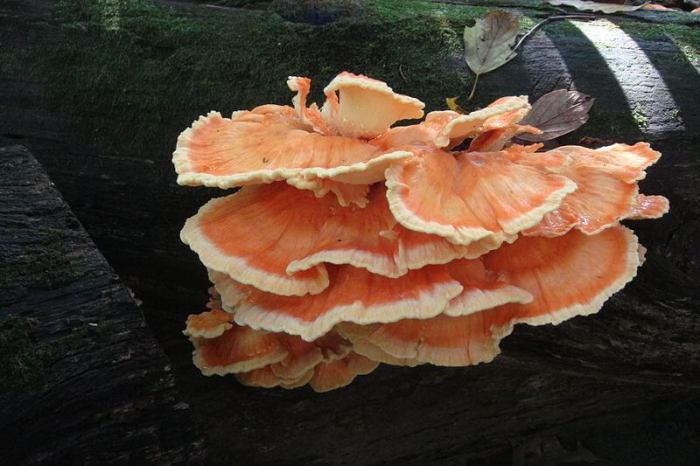
Prepare to embark on a culinary adventure with the captivating chicken of the woods recipe. This delectable mushroom, with its vibrant hues and earthy flavors, is ready to grace your table and tantalize your taste buds.
Our comprehensive guide will lead you through every aspect of this extraordinary ingredient, from foraging and identification to tantalizing cooking techniques and flavor combinations. Discover the nutritional wonders of chicken of the woods and learn how to preserve its freshness for future culinary delights.
Cooking Techniques
Chicken of the woods, a versatile mushroom with a meaty texture and delicate flavor, can be cooked using various techniques to enhance its unique characteristics. Each method offers distinct advantages, resulting in different textures, flavors, and aromas.
Sautéing
Sautéing involves cooking chicken of the woods in a pan with a small amount of fat, such as butter or oil. This technique allows for precise control over the cooking temperature, ensuring even browning and a tender texture. Sautéed chicken of the woods develops a slightly crispy exterior while retaining its moist and flavorful interior.
Ingredients:
- 1 pound chicken of the woods, torn into bite-sized pieces
- 2 tablespoons butter
- 1/4 teaspoon salt
- 1/4 teaspoon black pepper
Instructions:
- Heat the butter in a large skillet over medium heat.
- Add the chicken of the woods and cook, stirring occasionally, until browned and tender, about 5-7 minutes.
- Season with salt and pepper to taste.
Flavor Combinations

The earthy, slightly sweet flavor of chicken of the woods makes it a versatile ingredient that pairs well with a wide range of flavors. Herbs and spices like thyme, rosemary, sage, and garlic complement the mushroom’s natural flavors, while sauces and marinades can add moisture and richness.
Some specific flavor combinations that enhance the taste of chicken of the woods include:
Grilled with Lemon and Herbs
- Grilled chicken of the woods with lemon juice, olive oil, thyme, and rosemary
- This combination brings out the mushroom’s natural sweetness and adds a bright, citrusy flavor.
Sautéed with Garlic and Soy Sauce
- Sautéed chicken of the woods with garlic, soy sauce, and sesame oil
- The umami-rich soy sauce and garlic enhance the mushroom’s savory flavors, creating a dish that is both flavorful and satisfying.
Roasted with Balsamic Glaze
- Roasted chicken of the woods with balsamic glaze, honey, and thyme
- The sweet and tangy balsamic glaze adds a depth of flavor to the roasted mushroom, while the honey and thyme provide a touch of sweetness and earthiness.
These are just a few examples of the many flavor combinations that can be used to enhance the taste of chicken of the woods. By experimenting with different herbs, spices, sauces, and marinades, you can create unique and flavorful dishes that showcase the versatility of this delicious mushroom.
Nutritional Value: Chicken Of The Woods Recipe

Chicken of the woods is an excellent source of nutrition, providing an array of essential vitamins, minerals, and antioxidants. Its high protein content makes it a suitable meat alternative for vegetarians and vegans.
Compared to other edible mushrooms, chicken of the woods stands out for its exceptional nutritional value. It contains significantly higher levels of protein, fiber, and antioxidants than common mushrooms like white button mushrooms or oyster mushrooms.
Health Benefits
- Protein:Chicken of the woods is a rich source of protein, containing all essential amino acids necessary for human health. Its protein content is comparable to that of chicken or beef, making it an excellent choice for those looking to increase their protein intake.
- Fiber:Chicken of the woods is a good source of dietary fiber, which promotes digestive health and helps regulate blood sugar levels. Fiber also contributes to satiety, making it a satisfying and filling food.
- Antioxidants:Chicken of the woods contains various antioxidants, including ergothioneine, which has been linked to reducing inflammation and protecting cells from damage.
Incorporating into Diet
Chicken of the woods is a versatile ingredient that can be incorporated into various healthy meals and snacks. It can be sautéed, grilled, roasted, or added to soups, stews, and salads.
Chicken of the woods, a sought-after mushroom for its savory flavor, can be easily prepared with a chicken of the woods recipe . Simply clean and cut the mushrooms, sauté them in butter or olive oil, and season to your liking.
This versatile dish can be enjoyed as a standalone entrée or added to soups, stews, or pasta dishes.
Here are some ideas for incorporating chicken of the woods into your diet:
- Sautéed chicken of the woods with garlic and herbs as a side dish
- Grilled chicken of the woods skewers with vegetables
- Roasted chicken of the woods with root vegetables
- Chicken of the woods soup with wild rice
- Chicken of the woods salad with greens, nuts, and fruit
Foraging and Identification

Chicken of the woods is a distinctive mushroom that is prized for its delicious taste and vibrant appearance. Understanding its key characteristics, safe foraging practices, and sustainable harvesting techniques is crucial for a successful and rewarding foraging experience.
Chicken of the woods is typically found growing on dead or decaying hardwood trees, especially oak, maple, and beech. It prefers warm and humid climates and is most commonly seen in late summer and fall. The mushroom is characterized by its bright orange to yellow color, which can vary in intensity depending on the species and age.
It has a fleshy, fan-shaped cap that can grow up to 12 inches wide and 6 inches thick.
Identifying Chicken of the Woods
Proper identification is essential to avoid poisonous look-alikes. Chicken of the woods has several key characteristics that distinguish it from similar species:
- Color:Bright orange to yellow, sometimes with reddish or pinkish hues.
- Shape:Fan-shaped or shelf-like, with a wavy or lobed margin.
- Texture:Fleshy and firm, with a slightly spongy consistency.
- Spores:White to cream-colored spores that are released from pores on the underside of the cap.
li> Habitat:Grows on dead or decaying hardwood trees, especially oak, maple, and beech.
Sustainable Foraging
To ensure the preservation of chicken of the woods, it is essential to practice sustainable foraging. Here are some guidelines to follow:
- Leave some behind:Only harvest a portion of the mushroom, leaving the rest to continue growing and reproduce.
- Cut, don’t pull:Use a sharp knife to cut the mushroom at the base, avoiding damage to the mycelium.
- Respect the environment:Avoid trampling or disturbing the surrounding vegetation.
- Know your limits:Harvest only what you need, and be mindful of others who may also be foraging.
Preservation Techniques

Preserving chicken of the woods extends its shelf life, allowing you to enjoy its unique flavor throughout the year. Various methods can be employed to preserve this mushroom, each with its advantages and drawbacks.
For a more indulgent take on this culinary delight, try the chicken of the woods recipe that involves grilling the mushrooms. By grilling, you enhance their smoky flavor, creating a mouthwatering treat that’s perfect for summer gatherings. Serve with a side of grilled vegetables or a refreshing salad for a complete meal.
Drying, Chicken of the woods recipe
Drying is a simple and effective way to preserve chicken of the woods. It removes moisture, inhibiting spoilage and concentrating the mushroom’s flavor. To dry chicken of the woods:
- Slice the mushrooms thinly.
- Spread the slices on a drying rack or baking sheet.
- Place in a warm, dry, and well-ventilated area.
- Turn the slices occasionally to ensure even drying.
- Once completely dry, store in an airtight container in a cool, dark place.
Advantages:Extends shelf life significantly, intensifies flavor, and reduces weight for easy storage.
Disadvantages:Requires time and space, may result in some loss of nutritional value.
Freezing
Freezing is a quick and convenient way to preserve chicken of the woods. It slows down enzymatic activity and microbial growth, preserving the mushroom’s texture and flavor. To freeze chicken of the woods:
- Clean and slice the mushrooms.
- Blanch the slices for 2-3 minutes to stop enzymatic reactions.
- Drain and cool the slices.
- Pack the slices in freezer-safe bags or containers.
- Freeze for up to 6 months.
Advantages:Preserves flavor and texture well, convenient and quick.
Disadvantages:May slightly alter the texture, requires freezer space.
Canning
Canning is a method that involves sealing chicken of the woods in airtight jars and processing them in a pressure canner. This method sterilizes the mushrooms, preventing spoilage and extending their shelf life significantly. To can chicken of the woods:
- Clean and slice the mushrooms.
- Fill sterilized jars with the mushroom slices.
- Add a brine solution or lemon juice to each jar.
- Process the jars in a pressure canner according to recommended times and pressures.
Advantages:Long shelf life, preserves flavor and texture well, allows for storage at room temperature.
Disadvantages:Requires specialized equipment, may alter the texture slightly.
Epilogue

As we conclude our culinary exploration of chicken of the woods, let the vibrant flavors and versatile nature of this mushroom continue to inspire your cooking adventures. Whether you’re a seasoned forager or a curious cook, this guide has equipped you with the knowledge and techniques to savor the culinary delights of chicken of the woods.
Key Questions Answered
What are the key characteristics of chicken of the woods?
Chicken of the woods is known for its bright orange to yellow coloration, often resembling a chicken’s feathers. It typically grows in clusters on trees, particularly oak trees.
How do I safely forage for chicken of the woods?
Proper identification is crucial. Look for the distinctive characteristics mentioned above. Avoid consuming any mushrooms you’re unsure about. Always consult with an experienced forager or use reliable field guides.
What are some creative flavor combinations for chicken of the woods?
Experiment with herbs like thyme and rosemary, spices like paprika and cumin, and sauces like teriyaki or soy. Marinating the mushrooms in a mixture of these ingredients can enhance their flavors.





